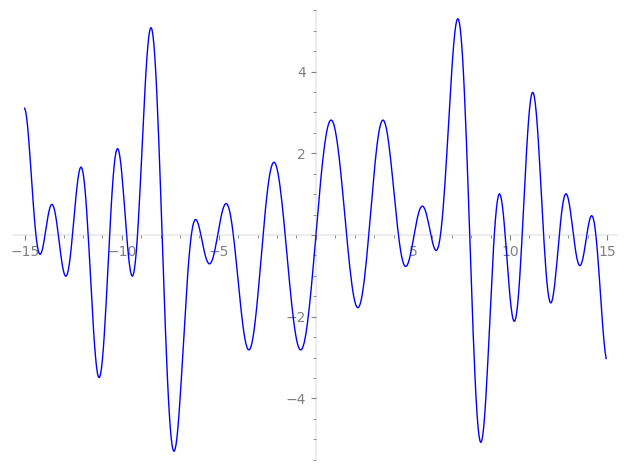| L(s) = 1 | + 4.45·2-s − 9·3-s − 12.1·4-s + 87.1·5-s − 40.0·6-s + 40.0·7-s − 196.·8-s + 81·9-s + 388.·10-s − 21.1·11-s + 109.·12-s − 223.·13-s + 178.·14-s − 784.·15-s − 485.·16-s − 777.·17-s + 360.·18-s + 431.·19-s − 1.06e3·20-s − 360.·21-s − 94.0·22-s − 4.34e3·23-s + 1.77e3·24-s + 4.47e3·25-s − 995.·26-s − 729·27-s − 488.·28-s + ⋯ |
| L(s) = 1 | + 0.786·2-s − 0.577·3-s − 0.380·4-s + 1.55·5-s − 0.454·6-s + 0.309·7-s − 1.08·8-s + 0.333·9-s + 1.22·10-s − 0.0526·11-s + 0.219·12-s − 0.367·13-s + 0.243·14-s − 0.900·15-s − 0.474·16-s − 0.652·17-s + 0.262·18-s + 0.274·19-s − 0.593·20-s − 0.178·21-s − 0.0414·22-s − 1.71·23-s + 0.627·24-s + 1.43·25-s − 0.288·26-s − 0.192·27-s − 0.117·28-s + ⋯ |
\[\begin{aligned}\Lambda(s)=\mathstrut & 471 ^{s/2} \, \Gamma_{\C}(s) \, L(s)\cr =\mathstrut & -\, \Lambda(6-s) \end{aligned}\]
\[\begin{aligned}\Lambda(s)=\mathstrut & 471 ^{s/2} \, \Gamma_{\C}(s+5/2) \, L(s)\cr =\mathstrut & -\, \Lambda(1-s) \end{aligned}\]
Particular Values
| \(L(3)\) |
\(=\) |
\(0\) |
| \(L(\frac12)\) |
\(=\) |
\(0\) |
| \(L(\frac{7}{2})\) |
|
not available |
| \(L(1)\) |
|
not available |
\(L(s) = \displaystyle \prod_{p} F_p(p^{-s})^{-1} \)
| $p$ | $F_p(T)$ |
|---|
| bad | 3 | \( 1 + 9T \) |
| 157 | \( 1 + 2.46e4T \) |
| good | 2 | \( 1 - 4.45T + 32T^{2} \) |
| 5 | \( 1 - 87.1T + 3.12e3T^{2} \) |
| 7 | \( 1 - 40.0T + 1.68e4T^{2} \) |
| 11 | \( 1 + 21.1T + 1.61e5T^{2} \) |
| 13 | \( 1 + 223.T + 3.71e5T^{2} \) |
| 17 | \( 1 + 777.T + 1.41e6T^{2} \) |
| 19 | \( 1 - 431.T + 2.47e6T^{2} \) |
| 23 | \( 1 + 4.34e3T + 6.43e6T^{2} \) |
| 29 | \( 1 + 2.31e3T + 2.05e7T^{2} \) |
| 31 | \( 1 - 5.94e3T + 2.86e7T^{2} \) |
| 37 | \( 1 + 2.17e3T + 6.93e7T^{2} \) |
| 41 | \( 1 - 7.58e3T + 1.15e8T^{2} \) |
| 43 | \( 1 - 1.71e4T + 1.47e8T^{2} \) |
| 47 | \( 1 + 1.60e4T + 2.29e8T^{2} \) |
| 53 | \( 1 + 2.75e4T + 4.18e8T^{2} \) |
| 59 | \( 1 + 1.66e4T + 7.14e8T^{2} \) |
| 61 | \( 1 + 1.62e4T + 8.44e8T^{2} \) |
| 67 | \( 1 + 6.06e4T + 1.35e9T^{2} \) |
| 71 | \( 1 + 4.70e4T + 1.80e9T^{2} \) |
| 73 | \( 1 - 4.01e4T + 2.07e9T^{2} \) |
| 79 | \( 1 - 1.49e4T + 3.07e9T^{2} \) |
| 83 | \( 1 + 8.94e3T + 3.93e9T^{2} \) |
| 89 | \( 1 - 1.75e3T + 5.58e9T^{2} \) |
| 97 | \( 1 + 8.21e4T + 8.58e9T^{2} \) |
| show more | |
| show less | |
\(L(s) = \displaystyle\prod_p \ \prod_{j=1}^{2} (1 - \alpha_{j,p}\, p^{-s})^{-1}\)
Imaginary part of the first few zeros on the critical line
−9.748252046970905820969495857060, −9.189164657647472959207572977802, −7.922015796970320241546876195703, −6.41591116318394398349644821511, −5.92437104550056478663286706609, −5.05827702326899160201010451056, −4.25248092890483340152821687716, −2.72043439544576227104338769977, −1.58262357160945869822579233543, 0,
1.58262357160945869822579233543, 2.72043439544576227104338769977, 4.25248092890483340152821687716, 5.05827702326899160201010451056, 5.92437104550056478663286706609, 6.41591116318394398349644821511, 7.922015796970320241546876195703, 9.189164657647472959207572977802, 9.748252046970905820969495857060

